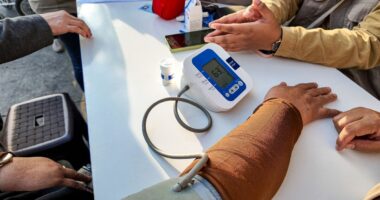Share this @internewscast.com
While most of us are well aware of the dangers of being in the sun without sunscreen, some may still have flashbacks to a particular sunburnt summer, health experts have warned that there is more to applying the protective block.
Over the last decade, melanoma skin cancer rates, primarily caused by ultraviolet (UV) radiation, have risen by 32 per cent in the UK, the National Institute for Health and Care Excellence (NICE) says.
Cancer Research UK contends that the number of new cases on average each year is predicted to continue rising by 9 per cent, resulting in around 26,500 cases in 2038-2040.
This year, the UK has experienced four heatwaves with temperatures expected to surge beyond 30°C across central and southern regions in the next few days.
Health officials have cautioned the public to stay safe in the sun by following the provided guidance, which urged people to avoid activities such as running or walking the dog during peak times and regularly applying SPF.
But, experts have sounded alarms on how Brits apply sunscreen, compiling a list of six common mistakes to avoid in order to give your skin the best protection against the sun.
Here they are:
1. Only Wearing SPF on Sunny or Hot Days
Most people skip sunscreen when it’s cloudy or cool, but UV rays still pose a risk and can cause skin damage, according to Dr Ross Perry, Dr Ross Perry, medical director of Cosmedics skin clinics.
“UV rays can penetrate clouds and still cause damage even when it’s overcast or cool, which is why SPF should be worn year-round,” Dr Perry explains.
Daily SPF use is essential, regardless of the weather, against UV rays, which contribute to aging and skin cancer, are present all year.
2. Not Applying Enough SPF
Using too little sunscreen drastically reduces its effectiveness.
“Most people use far less than the recommended amount. For full body coverage, you need around a shot glass-sized amount,” Dr Perry continues.
He also stresses you should reapply every two hours, especially after swimming or sweating. Commonly missed areas include the scalp, ears, eyelids, neck, and feet, all of which are vulnerable to sun damage.
3. Applying Your SPF Too Late
“It should be applied at least 15–20 minutes before sun exposure to allow it to absorb properly,” Dr Perry advises.
This window allows the active ingredients to bond with the skin and form a protective barrier.
4. Avoiding SPF Due to Cancer Myths
Misinformation surrounding health topics can often lead to avoidable ailments, and it’s no different when it comes to applying sunblock.
Dr Tim Woodman, medical director for Cancer Services, Bupa UK Insurance, said: “SPF protects you from cancer, and there’s no good evidence that shows wearing SPF causes cancer.
“If you’re concerned about ingredients in regular chemical sun creams, try a mineral-based sun cream.
“These cost a bit more and take longer to rub into your skin, but
generally contain fewer ingredients than chemical SPFs.”
5. Relying on SPF Present in Makeup
Some makeup contains SPF, which is helpful but insufficient, Dr Woodman warns.
“The amount of SPF in these products is too little to provide adequate protection.”
Kimberley Medd, clinic lead at Face The Future, adds: “Moisturisers with SPF often provide a lower level of protection than regular sunscreens.”
Layering SPF products doesn’t increase protection linearly. Instead, it can dilute its effectiveness. Makeup SPF is often low, around SPF 15–30, and not applied in sufficient quantity.
For reliable coverage, use a dedicated broad-spectrum sunscreen with SPF 30 or higher underneath your makeup.
6. Choosing the Wrong SPF Product
Low SPF, expired products, or poor spectrum coverage can leave skin vulnerable.
To avoid this, Dr Woodman advises: “Choose an SPF with broad spectrum coverage… ideally, choose an SPF that has a UVA rating of at least four stars (ideally 5).
“Check your label to make sure that the SPF hasn’t expired, especially if you’ve had it for a while. And always store your SPF in a secure, cool and dark place.”
Dr Woodman also stresses the importance of checking your skin regularly to identify any newly-formed moles.
“It’s important to get to know your skin and to look out for changes,” he explained.
“If you notice new skin lesions appear, or if a mole has changed in shape, size or colour, or starts to itch, bleed or look uneven, it’s important to get it checked by a registered dermatologist as these can be early signs of skin cancer.
“The quicker you get it checked, the better. If you’re concerned about a skin issue, there are services available that can help you get fast access to expert care.”













